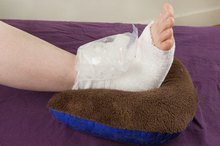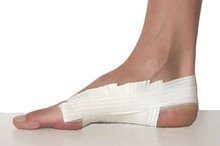How to Use an Athletic Wrap for Foot Arches
Pain the arch of your foot can have several causes, including plantar fasciitis, posterior tibial tendinitis and medial tibial stress syndrome, according to Podiatry Today 1. As the "British Journal of Sports Medicine" points out, arch pain is sometimes linked to injuries on the inside, or medial side, of the leg and at the knee 2. To relieve the pain associated with these conditions, as well as to prevent further injury, use athletic taping techniques to support and stabilize the arch 13. The low-dye taping technique is generally easier to master, but the X-crossing technique may offer slightly greater support for the plantar region of the foot.
If you are experiencing serious medical symptoms, seek emergency treatment immediately.
Low-Dye Technique
Place your foot in a neutral position (not flexed or pointed) with the big toe bent downward slightly.
Have Heel Spurs? How to Strap Your Foot
Learn More
Wrap a 1-inch wide strip of tape around your heel, beginning at the bottom of your big toe and ending under the bottom of your pinkie toe. Keep the tape low on the ankle so you do not irritate the Achilles tendon, but not so low that it's under the heel.
Wrap the tape under your arch toward the inside of your foot. Begin on the outside of your foot, and use 2-inch strips. Continue to place strips across your arch, overlapping them by one half each, until you have strips from the bottom of the ball of your foot to the beginning of your heel.
How to Wrap Achilles Tendon
Learn More
Repeat Step 2, adding another anchor wrap around your heel to secure the arch strips.
- Place your foot in a neutral position (not flexed or pointed) with the big toe bent downward slightly.
- Wrap a 1-inch wide strip of tape around your heel, beginning at the bottom of your big toe and ending under the bottom of your pinkie toe.
X-Crossing Technique
Place the foot in a neutral position with the big toe bending downward slightly.
Wrap the tape from the bottom of your big toe around your heel and back across the bottom of your foot to the starting position. Use a 1-inch-wide strip. The tape should go from inside the foot to outside the foot.
Cut a long strip of tape to apply in an "X" across the arch of your foot. Apply one end of the tape at the bottom of your pinkie toe. Bring the tape across the arch and wind it around the back of the heel. Cross back over the tape at the arch and anchor the end under the big toe. The tape should form an “X” on the underside of your foot's arch.
Place several 2-inch strips from the outside of your foot toward the inside, going over the "X" that is formed by the tape under your foot at the arch.
Tips
It can be helpful to have someone else wrap your feet for you so that the tape does not wrinkle or become too tight. Shave your feet and thoroughly clean them before applying the tape.
Warnings
Athletic tape can irritate skin. Using an underwarp can reduce that irritation.
- Place the foot in a neutral position with the big toe bending downward slightly.
- Cut a long strip of tape to apply in an "X" across the arch of your foot.
Related Articles
References
- Podiatry Today: Athletic Taping of the Foot and Ankle
- "British Journal of Sports Medicine"; Anti-Pronation Tape on the Medial Longitudinal Arch; B. Vicenzino et. al., 2005
- Athletic Advisor: Arch Tape
- Stearne SM, McDonald KA, Alderson JA, North I, Oxnard CE, Rubenson J. The Foot's Arch and the Energetics of Human Locomotion. Sci Rep. 2016;6:19403. doi:10.1038/srep19403
- National Institutes of Health (US); Biological Sciences Curriculum Study. Information about the Musculoskeletal and Skin Systems. In: NIH Curriculum Supplement Series [Internet]. Bethesda, MD: National Institutes of Health (US); 2007.
- Kim EK, Kim JS. The effects of short foot exercises and arch support insoles on improvement in the medial longitudinal arch and dynamic balance of flexible flatfoot patients. J Phys Ther Sci. 2016;28(11):3136-3139. doi:10.1589/jpts.28.3136
- Moon DC, Kim K, Lee SK. Immediate Effect of Short-foot Exercise on Dynamic Balance of Subjects with Excessively Pronated Feet. J Phys Ther Sci. 2014;26(1):117-119. doi:10.1589/jpts.26.117
- López-López D, Vilar-Fernández JM, Barros-García G, et al. Foot arch height and quality of life in adults: A strobe observational study. Int J Environ Res Public Health. 2018;15(7):pii: E1555. doi:10.3390/ijerph15071555
- Tong JW, Kong PW. Association between foot type and lower extremity injuries: systematic literature review with meta-analysis. J Orthop Sports Phys Ther. 2013;43(10):700-714. doi:10.2519/jospt.2013.4225
- Dufour AB, Losina E, Menz HB, LaValley MP, Hannan MT. Obesity, foot pain and foot disorders in older men and women. Obes Res Clin Pract. 2017;11(4):445–453. doi:10.1016/j.orcp.2016.11.001
- Hume P, Hopkins W, Rome K, Maulder P, Coyle G, Nigg B. Effectiveness of foot orthoses for treatment and prevention of lower limb injuries: a review. Sports Med. 2008;38(9):759-779. doi:10.2165/00007256-200838090-00005
- Zhao X, Wang M, Fekete G, Baker JS, Wiltshire H, Gu Y. Analyzing the effect of an arch support functional insole on walking and jogging in young, healthy females. Technol Health Care. 2018 Nov 9. doi:10.3233/THC-181373
Writer Bio
Lisa Atkinson has been writing health and fitness articles since 2000. She is a regular contributor to "The Fitness Motivation Monitor" health and fitness newsletter and to "The Rehab Connection." She has a Bachelor of Science in exercise physiology from the University of Massachusetts and is certified as a medical exercise specialist and health and fitness coach.









